That moment of Millennium magic
That moment of Millennium magic
By Dave Saltman
On Monday the 7th of February, I reviewed the pitch surface at the Millennium Stadium in Cardiff. It was two days after the Wales versus England, RBS Six Nations game. There had been substantial damage caused by the teams in their attempts to progress in the Championship.
My immediate thoughts were about getting the pitch surface in a fit condition for a football friendly international, due to be played on the Wednesday evening.
In the meantime, I also spoke to ex-Fulham Groundsman, Martin Chivers, he and a friend drove down to help me change the pitch around from rugby to football. This entailed hand washing the rugby lines out and measuring up for the football lines and new mowing bands. The rugby pitch measures 100 metres in length, the football pitch length extends another five metres.
The Kestrel boys arrived after lunch and set about excavating areas that I had designated. Nearly 400 metres of turf was ordered and by mid afternoon, was being harvested and put onto lorries to make the way down from Lindum's Lincolnshire fields. There was a lot of work to complete within the time scales, and by Tuesday afternoon, one half of the pitch had been repaired with new turf, the pitch lightly marked although it remained unmowed. We also turfed over the rugby sockets and found the football sockets. One goal was installed and nets hung in readiness for the Hungarian team to train that evening.
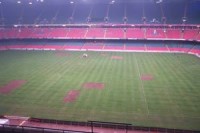
We started early on the Wednesday morning, but Martin and I had to wait for the last holes to be turfed before we could at last put the mowers on the surface. I walked the pitch with the Welsh FA secretary, reassuring him that we would be able to get the pitch in a playable condition for the game.
By midday, the Kestrel lads had finished the turfing; a couple of their lads stayed on to give us an extra hand in the final preparations of the surface. While we mowed and then over marked the whole pitch, the lads walked the bands, forking up low spots and adding in top dressing to correct levels. The other goal posts were erected and nets hung.
I hadn't watered the pitch for the training session the night before, to gauge how much we might need. I decided in the end just to give the pitch a quick sprinkle, enough just to wet the leaf and grease the surface.
The game came and went, Wales won 2-0 and although there were a few bobbles, the pitch didn't affect the game too much.
On the Thursday morning, I sat down with the stadium management and Jonathan Smith from the STRI. We discussed the immediate future and with the Carling Cup Final only two weeks away and the final Six Nations game against Ireland only five weeks away, it was decided that the entire pitch had to be re-turfed. Jon very kindly drew up a contract and tender specification for me, and I e-mailed the documents out first thing on Friday morning to eight contractors. With the clock ticking, there was no time to lose and the contractors had literally 24 hours to price and submit their quotes back to me for consideration. They also had to nominate and provide me with contact details of their preferred turf supplier. 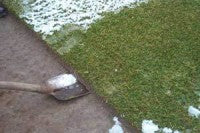
On Saturday morning I drove down to my office in Wolverhampton to pick up the faxed back completed tenders, and thenset off towards Lincolnshire to view the turf fields. In all, I saw six fields at two farms, before driving home to Shropshire that evening.
At five am Sunday morning my partner, Nicky, and I left our house, and drove to Liverpool airport to meet Ian Hodgkinson of S.F Hodgkinson and Sons Ltd and take a trip over to Holland. Ian had already been recommended to me by a number of friends including Chris Hague (Parken Stadium, Copenhagen).
Ian's business partner John Hendriks met us at Schippol airport and John drove us about an hour and a half south from Amsterdam to his turf fields. On the way we picked up a shovel from his production yard, it was snowing quite heavily and we would have to shovel off snow to see the turf.
My primary concerns for the turf was its tensile strength, not so much for the Carling Cup final, but for the Wales versus Ireland Six Nations rugby match on March 19th. On arrival at the field of turf that John and Ian had designated, we shovelled off a layer of snow, and cut out a piece. I tried to pull the sample apart and it displayed incredible strength. The turf was over two years old and grown on a sand rootzone that conformed to the German Din Norm standards for rootzones. It was 100% sand and there were no silt or clay particles.
A simple enough decision to make? It was made much harder by the grass species present. The turf had a 100% sward of Poa pratensis, although there were a number of cultivars (undisclosed). Now, I've read plenty of articles about its widespread use in North America and Southern Europe, and Groundsmen such as Simon Jacob and Dave Roberts have, for a number of years, tried to establish this grass species into their pitches in the UK.
I sat looking at the field and made a number of calls to provide me with reassurance. I had to make a quick decision. In the end I based it on the fact that no turf had ever survived that well in the harsh environment of the Stadium and I didn't have that much to lose by giving it a go.
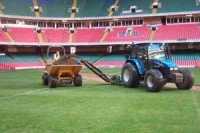
By the Tuesday morning Ian had deployed his team to the stadium and started to strip off the existing vegetation to a depth of 22mm with a Koro and three dumpers. By that evening all the grass had been removed. On Wednesday the lads started to prepare the surface with a huge 4 metre stone rake and also top-dressed around a hundred tonnes of rootzone to make up any levels that needed to be addressed.
The first articulated lorries turned up late afternoon from Holland with the machinery required to lay the now en-route turf.
On Thursday morning I met the Hendriks team from Holland. The team worked vigilantly to attain final levels. At about 9:30 am, the first turf was laid and we began to witness an amazing process. I can't really begin to describe what we saw, other than to say that the 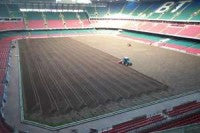
To put this in perspective they laid 1280 square metres in the first hour of operation; every line of turf butted tightly to the previous line.
I sat and watched the work all day with my newly appointed Head Groundsman, Lee Evans, and Jonathan Smith. We were in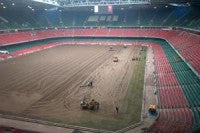
All the while, Ian's team continued to stone rake in front of the rapidly expanding area of turf, in total the pitch was raked and tilthed five times.

Friday started and continued the same way as the previous day, and by about 3 pm the last line of turf had been laid and cut in. We had one lorry load of turf left over, and William and his team very kindly transported their laying machinery and the turf to Sofia Gardens, where the WRU (Welsh rugby Union) have a training facility. By 4:30 pm, they had laid another 28 rolls of turf behind the rugby pitch.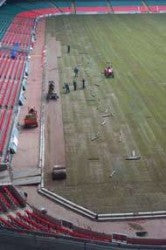
We had arranged with our local spraying contractor, Alan Abel (Complete Weed Control), to come in on Saturday morning to spray the pitch with 50 litres of winter liquid feed, 40 litres of Blade (sugar) and a fungicide (Heritage). Once sprayed we left the pitch alone to acclimatise after its long journey.
The Hodgkinson/Hendriks partnership finished sweeping up and cleaning the working areas within the stadium by Saturday lunchtime.
Countdown to the Carling Cup Final
On the Monday, I met with Paul Sergeant the stadium manager at Sofia Gardens and we asked Alan Phillips (Welsh Manager) if the Welsh pack could try a few scrummages on the spare turf that had been laid there. They had a few practices on one area and then moved to another section to have a proper workout. Paul and I watched as they threw the ball into the scrum six times on the same spot, 16 players pushing hard against each other, turning the scrum around and digging in. At the end of this workout, we reviewed the turf, and to our delight the players hadn't managed to break through the surface.
At this point I felt more comfortable with my decision to purchase this turf.
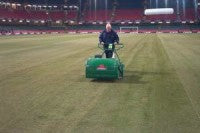
There is the facility of an underground heating system that blows warm air up through vents under the pitch. The system was never commissioned properly from the time the stadium opened, and recently Lee had been working with the heating engineers to get it working efficiently. They are currently devising a new software program that will allow us to control the heat.
We had turned the system on, and it was blowing air into the stadium at 15 degrees Celsius. Lee had called in a firm to test soil temperatures and moisture. The soil temperature readings showed plus eight degrees in the middle of the pitch, but the edges of the pitch only reached about five degrees. Where the temperatures were raised sufficiently in the middle we started to notice a greening up of the grass, which was encouraging. 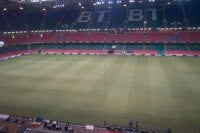
Lee and his assistant, Matthew, were able to get some presentation on the widthways mowing bands, but long ways the mowing bands didn't really appear and the turf lines were still visible. We talked about spraying the pitch with a dye such as GreenLawnger, but in the end decided that it was yet another operation that the dormant grass could do without. Our main concern was obviously the stability and overall levels and these were excellent for the game of football. Presentation was a secondary objective at this point in time.
The Carling Cup Final day arrived, the pitch played as expected, in fact it resembled 'a start of season' re-enforced Desso type surface. We suffered nothing more than some superficial scars. The feedback that we gathered from the players was good, the surface was firm, with a little give in it and the ball moved freely around the pitch without any bobbles.
We now had just short of three weeks to get the pitch ready for the finale to the RBS Six Nations Tournament. As each weeks rugby results occurred it became increasingly likely that Wales and Ireland would battle it out for the title in the final match at the Millennium Stadium.
Lee and Matt repaired the pitch after the football on the Monday, and managed to do some more repairs during the rest of the week, in between filming of the Dream Team and another film shoot by a Japanese crew, who'd also hired the use of the stadium.
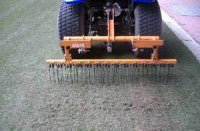
The following week, after a well-earned weekend of rest, the lads started removing the football lines; all the lines need to be washed out, using specially modified brushes and water.
I had asked SISIS if they had a tractor mounted rake available, and David Harrison said they had developed a new thinner tined prototype version that we could borrow. This was kindly sent down to us from Macclesfield.
Lee set it up on a single play frame and raked the pitch. The thin tines worked well to scrape up the winter die back that lay in the base of the sward. The tines also didn't seem to affect the healthy grass, so Lee followed this operation with the Litamina to sweep up all the debris. It certainly thinned the sward, but the grass at last started to stand up and looked far healthier for the work.
Alan Abel was invited to spray the pitch again, this time he put on 40 litres of chelated Iron, 10 litres of Amino acids and 10 litres of Triple seaweed.
The Welsh team had requested if they could hold a training session on the pitch on the Wednesday. We decided that if we could help in any way we would, so we agreed. Lee and Matt erected the rugby posts and while there were no pitch markings, the team enjoyed the hour and a half session. In fact they enjoyed themselves so much that they asked to train again the following day before flying up to Murrayfield for the game against Scotland.
After each training session, Lee and Matt used forks to close up any scars and picked off any debris with buckets. It was a dry week and the irrigation was utilised each day.
The week building up to the Ireland match became a massive week, the team went to Scotland and won, providing them with a two-point cushion. The Welsh squad again asked if they could train on the pitch on Thursday as well as the planned Captain's walk through on Friday, (a concession afforded to both teams). At this stage we felt that we had no choice, I mean who would stand in the way of a team's chance to win the Grand Slam!
The week started well enough, the warmer temperatures saw the grass continue to stir and grow. The colour started to improve dramatically and Lee and Matt embarked on a presentation campaign. They measured 2.5 metre bands on the pitch edging, corresponding to the 5, 10 and 40 metre line markings and then proceeded to cut the pitch in these blocks.
On Tuesday they continued mowing, improving the presentation of the pitch with each operation. Although at 35mm, they weren't removing any grass clippings, the engaged blades helped to remove any debris off the surface and stand the grass up straight.
On Wednesday the heavens opened, and the pitch received a good dosing of 'Welsh drizzle'! In 24 hours about 30mm of rain fell. With the team due to train on the Thursday, Lee spoke to Alan Phillips (WRU Team Manager) to ask him to look at training venue alternatives. They agreed to have a pitch inspection at 7am the next day.
Thursday morning arrived and the pitch had drained very well, with the exception of heavy wear areas in front of the tunnel and the grass in the corner of the stadium immediately by the access ramp onto the pitch. These areas were roped off, and the players trained for around two hours across the rest of the pitch. Lee and Matt then worked the pitch with forks, making repairs, as soon as the players had finished.
We enrolled the help of a student from Hartpury College, thanks to his lecturer, Chris Rawlings. Iestyn John worked with us from Thursday until Saturday evening.
The penultimate day to possible Welsh rugby history. I arrived in Cardiff to add my support to Lee, Matt and Iestyn. Lee and Matt mowed the main pitch, lengthways, turning on boards at each end. I mowed the dead ball zone with Iestyn helping me to move our turning boards. We had to have the mowing finished by 11:30 am, before first the Irish and then the Welsh squad came in to do their Captain's walkthrough and kicking practice.
The stadium was very busy, with film crews setting up for interviews and live broadcasts. We had the Para's in, setting up a huge Welsh flag in the roof rafters, the commercial department had around 300 guests for a Champagne reception in the middle of the pitch in the evening and there were the pitch logo guys painting the RBS logos on the ends and the middle of the pitch too.
The logo guys painted the end zones as soon as Iestyn and I had completed the South End. They then went off for the afternoon, while training was taking place, before returning to paint the middle. Once the training finished, Lee and Matt did a final mow crossways, starting from the middle out, so the logo could then be completed on the centre.
Finally we laid out some carpets for the corporate guests to walk out on for their party.
We finished work at about 8pm and I retired to the hotel.
Matchday

At 11am, Event 360 (Production Company) started stage rehearsals. This involved around 30 soldiers carrying sections of staging onto the centre of the pitch. The IRB and RBS sponsors reviewed the stage to make any refinements and then the stage was removed. The soldiers then did another dummy run to make sure that the operation would run smoothly (if the stage was required at the end of the game!)
By Midday the stadium was filling up with stewards, press, St John's etc, and you could hear the atmosphere building outside the stadium. We continued to work on the pitch, hand picking any debris, putting on post protectors, hand brushing the mowing bands in the end zones and installing all the flags. There were film crews setting up off the pitch, on the side of the pitch and conducting interviews on the pitch, including a crew from CBBC. Max Boyce and the very lovely Catherine Jenkins and Charlotte Church practiced their sound checks, Max in particular entertaining the privileged few with his version of 'Bread of Heaven'.
We filled buckets with sand, pegged down a WRU mat in front of the tunnel, cleaned the track, moved all our equipment back to our machinery room, put out benches and barriers by the dugouts and removed our two heavy access ramps from the pitch side with a forklift. The grass clippings that I had collected earlier were used to disguise any faint football markings still visible.
Now we had time to grab a bite to eat and soak up some of the day.
The players came out to warm up at 2:45pm and as soon as they had finished, some of our lads went out to check the pitch. Four of us congregated at the tunnel and awaited the players for their line up and introduction to the dignitaries before the game. Our duties include pulling the tunnel in/out before the start, at half time and at final whistle.
We listened to the anthems and then the players broke away to their respective halves ready for the start. The atmosphere sent shivers down your spine, it was awesome. This was the biggest day in Welsh rugby since 1978 and everybody in that stadium knew it.
For me, the worry wasn't yet over, I needed to see the first scrum for my piece of mind. I only had to wait about six minutes. The two packs went down and the immense pressure that two eight man groups exert on the ground is frightening. As the ball broke and play moved away from the area, there was little evidence that they had been there. No divots appeared, and I turned to Paul Sergeant in the tunnel with a probable look of relief.
The game was furious, there was no love lost, both teams still had a great chance of being crowned Six Nation Champions. At half time whistle we pulled the tunnel out quickly and got up on the pitch to review the damage. No divots still, just a few surface scars. We worked with buckets picking up debris that had been scuffed up by the player's boots.
The second half got underway and I retired to the Operations room to watch the game on the TV. In all I counted 31 scrums and many more rucks. On three occasions, where the scrum collapsed or the referee was unhappy, the scrum took place on the same spot three or more times.
When the final whistle went the stadium crowd erupted. The noise was deafening and we walked out onto the pitch to watch the Event 360 team bring out the staging. They had to be quick, because Grandstand's broadcast time finished at 5:25pm to go to the news. The ideal scenario was now being played out, the Welsh Grand Slam, players up onto the stage to receive their medals, and finally the Captain lifting the cup to a backdrop of pyrotechnics.
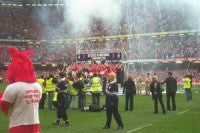
Once the players had run a lap of honour and disappeared down the tunnel, we started to repair the pitch and remove the inevitable rubbish that lay strewn across the surface. The pitch didn't look like there had been any more damage than for a game of football; it had stood the test well. Lee and I were relieved and delighted. Ian Hodgkinson had been watching the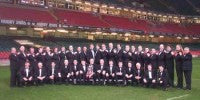
On reflection, there is still a long way to go with this new turf. We have had to change our maintenance regime to accommodate Poa pratensis, but so far the grass has performed very well, the turf has remained strong and we haven't really noticed much serious wear.
With spring here and with it warmer weather, grass recovery times should increase. The turf has now sent roots down 50mm into the fibre rootzoneunderneath, and there are lots of new shoots appearing. All the scuffmarks, where players slid, have new shoots appearing as well, so the scars should heal quickly.
Lee and I remain cautious about the turf's shelf life in the stadium, particularly with the coming fixture list, but for all those people worried about synthetic turf taking over, take note-I believe there is light at the end of the tunnel.
The Millennium Stadium re-turf is the first surface to have 100% smooth stalked meadow grass in the UK, already it may provide Groundsmen working in stadia environment with a possible alternative. The strength of the rhizomatous Poa root system makes for a strong surface without the need for additional fibre re-inforcement. This grass genus is used extensively in the USA and Europe in stadia and shows incredible resilience to wear. Like its cousin, Poa annua, it is a prolific grower in the right conditions, but with the addition of rhizomes as well as seed heads, the opportunity to reproduce is greatly enhanced.
We are aware that it requires a lot of thinning out during the growing season and will require overseeding with rye grasses in readiness for the winter months. It is also slightly more prone to disease and therefore we have already implemented a preventative fungicide program.
I will continue to update you all on our progress in Cardiff, it's a learning curve for us, but we're encouraged to date. If you would like to know more please feel free to e-mail me at dave@pitchcare.com.
